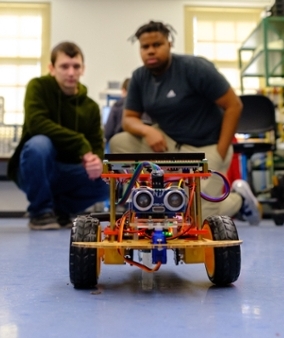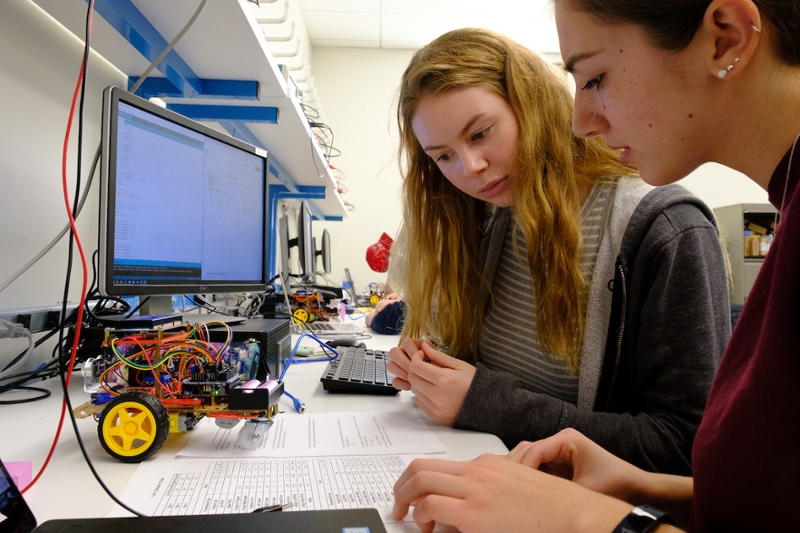

Miami developing bachelor's degree in robotics engineering
By Margo Kissell, university news and communications
[UPDATE: The state has since granted approval for this new degree.]
Inside a Garland Hall robotics laboratory, 34 Miami University engineering students were busy programming small robotic vehicles to navigate a straight line.
“That’s the best one I’ve seen today,” adjunct lecturer Jim Leonard told two students whose vehicle sped straight ahead for 11 seconds during a lab period for the class on robotics - vision and control.
This week, the students are learning how to program the vehicles to turn when approaching a wall. Eventually, they’ll drive into the hallway or on “roads” set up in the laboratory.
Welcome to Miami’s newest robotics class, which comes as the department of electrical and computer engineering is in the process of developing a bachelor’s degree in robotics engineering.
The goal is to gain state approval in the fall, said Clark Kelly, assistant dean of external relations and communications for the College of Engineering and Computing (CEC).
Leonard — who joined Miami in 2014 after retiring from the Air Force Research Lab at Wright-Patterson Air Force Base — is excited the university is pursuing the new undergraduate degree.
“Robotics is important because it is such a growing field and there are so many applications,” he said. “They range from the design of robots, industrial applications of robots, self-driving vehicles and drones.”
State funding boosts high-tech programs
The Ohio Department of Higher Education recently awarded Miami’s Oxford and regional campuses a combined $325,000 through the Regionally Aligned Priorities in Delivering Skills (RAPIDS) program.

Miami seniors Ross Cortino and Alex Onkst talk to adjunct lecturer Jim Leonard during their lab period (all photos by Scott Kissell).
RAPIDS capital equipment grants support education and training for in-demand jobs in southwest Ohio. Since 2016, the state has awarded Miami three RAPIDS grants totaling more than $1 million.
The current funding is pooled in Miami’s Boldly Creative Strategic Academic Enrichment Initiative fund to generate and fund promising academic programs (such as robotics), pioneering and cross-disciplinary research and other cutting-edge learning initiatives.
Meanwhile, Miami Regionals is working with Cincinnati State Technical and Community College to create flexible advanced manufacturing components integrating machines, robots, conveyors and sensors. This provides hands-on training for certificate and associate degree students, workers, Butler Tech students and other area high school students interested in advanced manufacturing.
"Under Miami's Boldly Creative initiative, the department of engineering technology on Miami Regionals will offer an approved bachelor's completion degree program in robotics engineering technology (BS-RET). This robotics degree program will benefit engineering technology associate degree holders from Cincinnati State, Sinclair Community College, Columbus State Community College and other two-year colleges in Ohio," said Ayo Abatan, chair and professor of engineering technology.
Several new robotics courses planned
Eight new courses have been designed for the robotics major, including computer vision, kinematics of robotics and sensors and data fusion.
The curriculum will be spread across three departments: computer science and software engineering, electrical and computer engineering, and mechanical and manufacturing engineering.
David Hartup, teaching professor in electrical and computer engineering, teaches the ECE 471/571 lectures while Leonard oversees the lab periods. The class filled up quickly and additional sections were added.
Graduate student Gabe Skidmore (Miami '19), on left, and senior Kevin Reed look at the robotic vehicle they programmed during lab period.
Among those taking the class are Greg Pope, a senior majoring in computer engineering, and Nicholas Holl, a junior majoring in electrical engineering. They spent the lab period entering a series of computer codes so their vehicle wouldn’t veer left or right.
“Robotics and automated intelligence are the future of the technology industry,” said Pope, who will become a software developer for a defense contractor in Dayton after he graduates in May.
Classmate Milena Brixey, a junior majoring in computer engineering, said there are so many different areas one can go into in computer and electrical engineering.
“All of these classes are giving us a little glimpse of what we could do ultimately and rounding us out enough so we can specialize in whatever we want,” she said.
Learning how a robot moves and “sees”
Gabe Skidmore (Miami ’19) — a graduate student pursuing a master’s in electrical engineering and computational electrical engineering with a focus in machine learning — said he has enjoyed learning how a robot moves and “sees.”
Skidmore looks forward to learning more about computer vision, which is how a robot detects an object.
Robotics has always been something people generally associate with the future, Skidmore said, but it’s quickly becoming reality.
“Our computers are starting to become good enough to actually do some of the things that people have been saying will come for the past 50 years,” he said.
Students provide valuable input
As Miami builds the robotics program, CEC leaders have sought input from Ross Cortino and other top students. The electrical engineering major plans to study robotics in graduate school after completing his second internship at Oak Ridge National Laboratory in Tennessee this summer.
“Often as undergrads, you don’t get that kind of input on things except for your evaluations at the end of year,” Cortino said, “so it’s really cool to have a hand in everything.”
Cortino and Alex Onkst, a senior majoring in electrical engineering, were collaborating in class to learn the Robot Operating System for a future project.

Malcolm Smitherman, a double major in computer engineering and computer science, worked behind the scenes so students could program the robotic vehicles to turn left or right.
Across the lab, senior Malcolm Smitherman worked away at his computer station. The double major in computer engineering and computer science with a physics minor isn’t a student in the class. But thanks to his behind-the-scenes programming work, the class will be able to do the next step of getting the robotic vehicles to turn left or right.Smitherman was putting the software onto the robotic vehicles’ small computers, which will interface with a rotating support arm holding a camera that will allow it to detect objects.
The students, in turn, program their robotic vehicles to search for objects or situations of interest to the programmer.
Smitherman said he has enjoyed the opportunity to work with the robotics class.
“There are a lot of things students learn from simple exercises like this,” said Smitherman, who will work as a software engineer for a Cincinnati software company after graduating in May. “Getting your hands wet is the only real way to learn, especially for engineering.”
